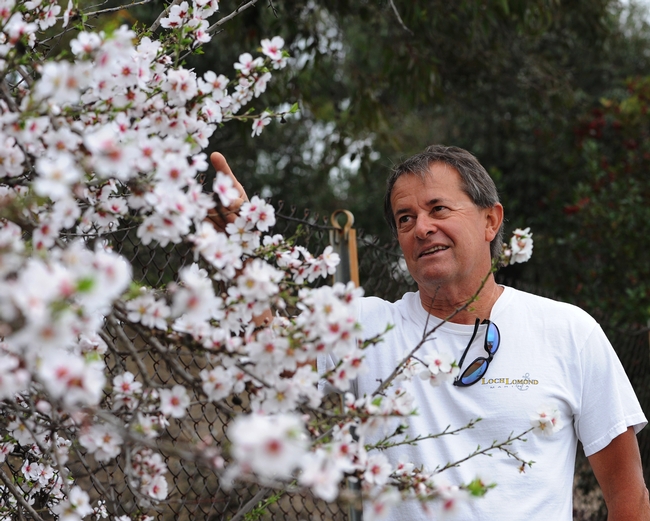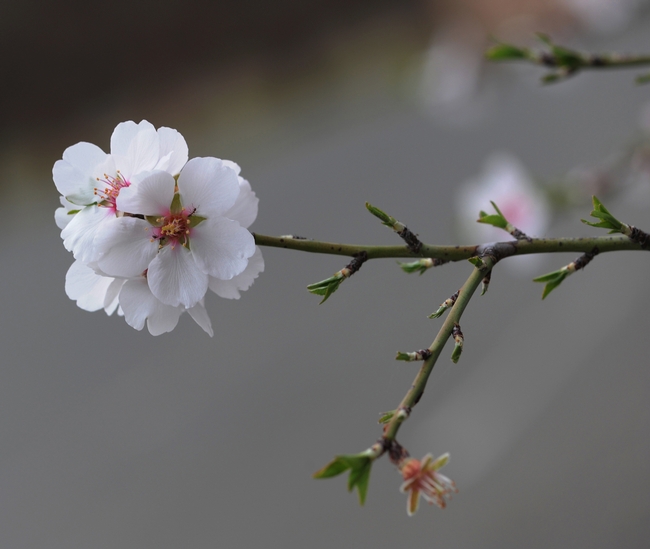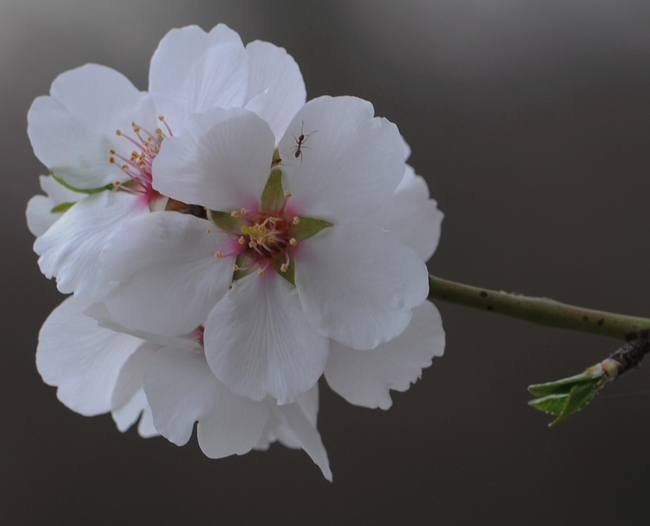- Author: Kathy Keatley Garvey
No, it's not Valentine's Day, yet.
Yes, the almonds are blooming.
No, it's not spring.
But it looks like spring in Benicia.
The almonds are blooming in the Benicia (Calif.) State Recreation Area.
Some are on the road at the entrance to the park.
Other trees are also blooming.
Benicia resident Gordon Hough, always on the lookout for those early blooms and elusive bees, photographed a honey bee nectaring on a Bradford pear blossom (as identified by Daniel Potter, UC Davis professor of plant sciences) in the Benicia park on Monday, Jan. 21. Gorgeous image!
Benicia (or Bee-nicia?) is graced with early almond blooms. We remember heading over to the Benicia State Recreation Area on the first day of 2014 and seeing almonds in bloom. Actually, several almond trees in the parking lot were blooming on Christmas Day of 2013. (See Bug Squad)
Meanwhile, California's commercial almond pollination season usually begins around Feb. 14.
Our state has more than a million acres of almonds in production, according to Kyle Kapustka of the Almond Board of California.
The 2017 California Almond Acreage Report, from USDA's National Agricultural Statistics Service (NASS), released April 25, 2018, estimated
- 1,330,000 total almond acres in California
- 1,000,000 bearing acres in California
The 1.3 million acres is up 7 percent from the 2016 acreage of 1,240,000, according to the report. "Nonpareil continued to be the leading variety, followed by Monterey, Butte, Carmel and Padre. Kern, Fresno, Stanislaus, Merced and Madera were the leading counties. These five counties had 73 percent of the total bearing acreage." (See overview of the almond industry on the Almond Board of California website)
Solano County, home of seven cities, including Bee-nicia, isn't one of them.
But don't tell that to the bees.
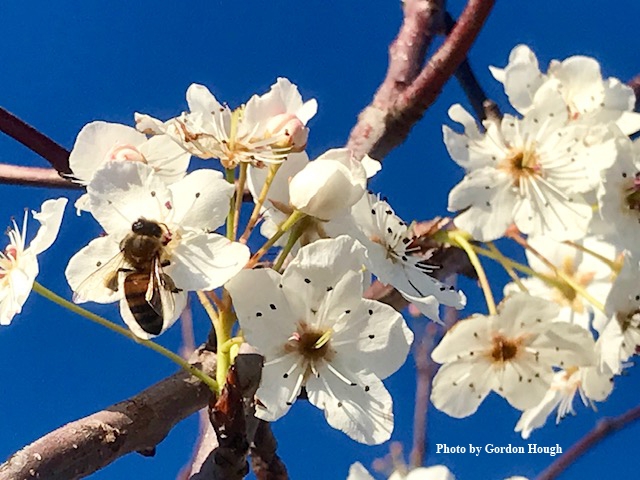
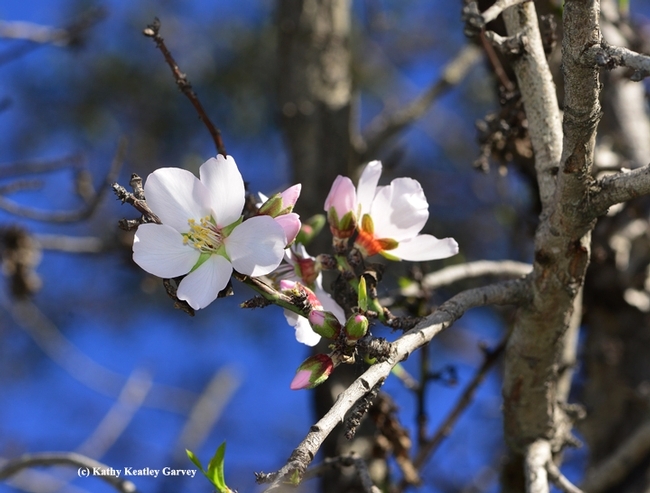
- Author: Kathy Keatley Garvey
We're accustomed to seeing honey bees pollinating the almonds.
But carpenter bees do, too.
We spotted a female Valley carpenter bee, Xylocopa varipuncta, foraging in an almond tree on Feb. 24 in a field adjacent to the Harry H. Laidlaw Jr. Honey Bee Research Facility on Bee Biology Road, University of California, Davis.
Sounding like a Boeing 747 Jumbo Jet, this lone carpenter bee buzzed loudly as she visited one blossom after another. She was on a mission: a do-not-linger, do-not-stop-me, and get-out-of-my-way mission.
The Valley carpenter bees, about the size of bumble bees, are the largest carpenter bees in California. The girls are solid black, while the boys are blond with green eyes. We can't count how many times people think the males are "golden bumble bees."
It's rare to get an image of "a blond and a brunette" (male and female) in the same photo. Gary Park, a contributor to BugGuide.net, did just that. Check out his amazing photos of a pair mating.
Carpenter bees derive their name from drilling holes in untreated, unfinished wood to make their nests. Only the females excavate the wood. Contrary to popular opinion, they do not eat the wood. To prevent these bees from nesting in your fence posts or deck, just paint or varnish the wood. We know some folks who like having them around and leave wood untreated and unfinished.
First and foremost, however, carpenter bees are pollinators. Excellent pollinators.
Native pollinator specialist Robbin Thorp, emeritus professor entomology at UC Davis, tries to convince people to live with these bees as “they are important pollinators in our environment and have potential as pollinators of some crops.”
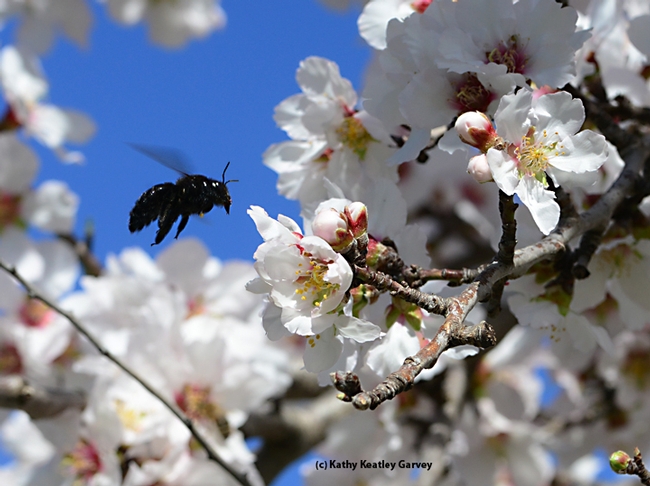


- Author: Kathy Keatley Garvey
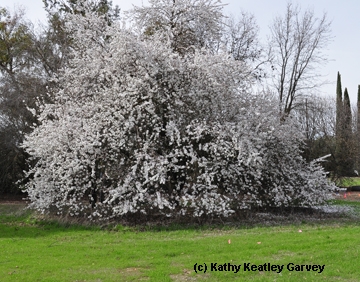
Mine--well, it's not exactly mine!--is on the grounds of the Harry H. Laidlaw Jr. Honey Bee Research Facility on Bee Biology Road, University of California, Davis.
It's spectacular in bloom. You can hear the buzz of honey bees, the tweeting of birds, and occasionally, an airplane droning over the field or a hog squealing from the nearby UC Davis hog farm.
But the sounds of the bees empower us and assure us that spring is coming. This particular almond tree, with its low hanging branches, is an addiction and a good place to get "a fix."
Meanwhile, 1.6 million honey bee colonies, trucked in from all over the United States, are pollinating California's 810,000 acres of almonds. Each acre requires two bee hives.
California growers produced 1.88 billion pounds of almonds for the 2012-13 crop year, according to Christine Souza's Dec. 11, 2013 article in Ag Alert. The 2013-14 crop is estimated at 1.85 billion pounds.
A little less than last year but that's a lot of almonds! And a lot of buzz in the almonds...



- Author: Kathy Keatley Garvey
You've heard of late bloomers.
How about early bloomers?
A trip to the Benica (Calif.) State Recreational Park on Sunday yielded quite a surprise: a solo blossom on a bare almond tree.
Almonds don't usually start blooming until around Valentine's Day.
Almonds are big business in California. "The 2013-14 crop is estimated at 1.85 billion pounds from 810,000 bearing acres," wrote Christine Souza in the Dec. 11 edition of Ag Alert.
Souza, who covered the 41st annual meeting of the Almond Board of California, wrote that "Near-record production, higher prices and room for increased export opportunities lead leaders in the almond business to forecast continued growth, with optimistic trends outweighing concerns about water supplies, increasing production costs and onerous government regulations." Read her full article.
Meanwhile, while buds turn to blossoms and blossoms turn into food for hungry honey bees, Extension apiculturist Eric Mussen of the UC Davis Department of Entomology and Nematology, keeps busy answering bee/almond questions. This year marks his 38th year as an Extension apiculturist. He will be retiring in June.
One of the questions recently posed to him: "Do most commercial beekeepers in California specialize in a certain area of beekeeping such as honey production, pollination services, queen bees, etc., or do most do a little of all of these things?"
"Most commercial beekeepers in California try to place as many of their colonies as they can in almond pollination," Mussen responded. "That $150 or so makes up a large portion of the total costs of keeping a colony alive for a year--about $220. After almonds, most of the commercial beekeepers (bee breeders) in the Sacramento Valley turn to raising queen bees and bulk adult bees for the most part, with some further pollination contracts to keep their 'spare' bees making some income. The northern California beekeepers will hardly ever produce an income-generating honey crop, unless they move their colonies out of state, which some do. Most of the bee breeders produce no reportable honey."
On the other hand, the San Joaquin Valley commercial beekeepers do attempt to earn their income after almonds from various honey sources and pollination contracts, Mussen says. "Before most crops are ready to be pollinated, the beekeepers swamp the San Joaquin citrus belt to make some honey and not have to feed their bees. There are so many resident and visiting colonies down there that the honey crop has become very small. Except for alfalfa seed pollination, most commercially pollinated crops do not produce honey. Beekeepers do place their colonies near cotton, sometimes, for a honey crop, but it is risky. The central valley beekeepers can attain the state average of 60 pounds of honey per colony, if the rains promote growth of the sage and buckwheat plants growing in the hills around the valley.
"The southern California beekeepers usually average the best honey crops--closer to 100 pounds per colony. There still is a significant amount of citrus down there, and quite a few wildflowers. Rainfall remains an extremely important factor."
And declining bee health? What about colony collapse disorder (CCD)?
"CCD seems to be a combination of stresses that, sometimes, becomes overwhelming to the bees," he says. "These are the contributing leading factors: malnutrition, parasitism by Varroa destructor, infections with Nosema ceranae, infections by one or more of the 22 known honey bee viruses, exposure to pesticides, and vagaries of weather, especially cold weather. Commonly, colonies that are collapsing are heavily infected by Nosema and one or more of the viruses."


- Author: Kathy Keatley Garvey
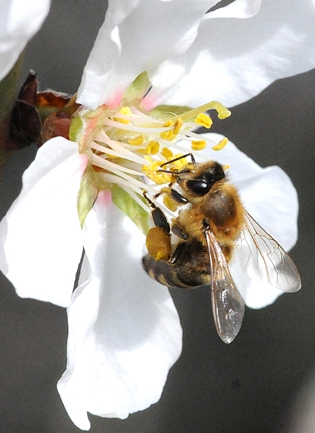
This year, however, thanks to the unseasonably warm weather, almond trees began blooming in late January in some parts of Central California.
Take the city of Benicia. Its temperate climate is conducive to early spring. Today as the temperature climbed to 58 degrees, we saw almond blossoms everywhere--at the entrance to Benicia State Park, in residential yards, in fields and meadows, and lining city streets and roads.
Benicia resident Gordon Hough, who owns and skippers the sports fishing boat, The Morning Star, didn't go fishing for sturgeon and bass today, but he did go jogging in Benicia State Park. On his way home, he stopped to check an almond tree for honey bees.
No bees. But one ant.
It should be a great year for almonds. The USDA's National Agricultural Statistics Service projects a record 2600-pounds-per-acre yield for the 2011-2012 California almond crop. That represents an increase of 200 pounds per acre, or 8 percent, over the previous yield-per-acre record set in 2008-2009, the NASS officials said.
This is what the California Almond Board had to say in its September 2011 newsletter: "The California Almond objective forecast for the 2011–12 crop year is 1.95 billion meat pounds, which is based on 750,000 bearing acres. Overall, shipments were up 13 percent, reaching 1.668 billion pounds and marking the fifth consecutive year of record shipments across domestic and export markets.
"For the second year, California shipped over 1 billion pounds to export destinations, an increase of 15 percent over 2010–11. Domestic shipments were up 9 percent over the previous year, at 490 million pounds. The top five export destinations (China, Spain, Germany, India and the United Arab Emirates) account for approximately 53 percent of total export shipments, while the top 10 destinations account for over 72 percent of export shipments. For the first time, China became the leading export destination, with shipments rising by 26 percent to reach 168 million pounds."
Meanwhile, it takes two hives per acre to pollinate California's 750,000 acres. The bees, trucked here from all over the country, are in holding yards and ready to go.
The orchards will be abuzz soon with millions of bees pollinating the blossoms.
